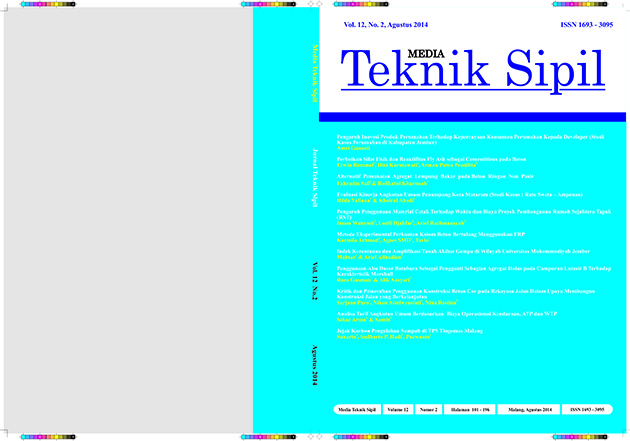JEJAK KARBON PENGOLAHAN SAMPAH DI tps tlogomas malang
DOI:
https://doi.org/10.22219/jmts.v12i2.2291Abstract
JEJAK KARBON PENGOLAHAN SAMPAH DI tps tlogomas malangCarbon Footprint of Solid Waste Processing At TPS Tlogomas Malang
Sunarto1, Sudharto P. Hadi2, Purwanto3
1,2,3Program Doktor Ilmu Lingkungan Universitas DiponegoroAlamat korespondensi : Jl. Imam Bardjo, SH No. 3 Semarang 50241Email: 1) narto@umm.ac.id, 2) sudhartophadi@yahoo.co.id.
Abstract
Waste sector is one of human activities that cause global warming. Decomposition of organic waste in landfill produces greenhouse gas emissions in the form of biogas consisting of methane and carbon dioxide. Solid waste processing in transfer station in the form of recycling and composting product potentially reduce carbon footprint, directly from the reduction in the volume of waste dumped in landfill and indirectly from the recovery of material. The purpose of this study was to determine the carbon footprint of waste processing at the transfer stations of Tlogomas Malang if developed several scenarios to enhance the capacity of processing. Life cycle approach is used to assess carbon footprint of waste management scenarios with the help of software SWM-GHG Calculator. The results showed that the processing of solid waste at current recycling rate of 40,57% – 80,41% (Status Quo) resulted in net carbon footprint of 1.147 ton CO2–eq /year. Increasing of processing capacity to 60 - 88% (Scenario 1) and 90 - 95% (Scenario 2) would reduce net carbon footprint to 801 ton CO2–eq /year and427 ton CO2–eq/year respectively. If the processing of waste in transfer station of Tlogomas was discontinued (Scenario 3), net carbon footprint increased to 4,063 t CO2-eq/year.
Keywords: carbon footprint, greenhouse gases, solid waste processing, life cycle analysis.
Abstrak
Sektor persampahan merupakan salah satu kegiatan manusia yang menyebabkan pemanasan global. Proses dekomposisi sampah organik pada timbunan sampah menghasilkan emisi gas rumah kaca berupa biogas yang terdiri atas gas methana dan gas karbon dioksida. Pengolahan sampah di TPS untuk produk daur ulang dan kompos berpotensi mereduksi jejak karbon secara langsung dari penurunan volume sampah yang dibuang ke TPA dan secara tidak langsung dari pemulihan material sampah. Tujuan penelitian ini adalah untuk mengetahui jejak karbon pengolahan sampah di TPS Tlogomas di Kota Malang jika dikembangkan beberapa skenario pengolahan untuk meningkatkan kapasitas pengolahan sampah yang telah dilakukan selama ini. Pendekatan daur hidup digunakan untuk menaksir jejak karbon dari beberapa skenario pengolahan sampah di TPS dengan bantuan perangkat lunak SWM-GHG Calculator. Hasil analisis menunjukkan bahwa pengolahan sampah pada saat ini dengan tingkat daur ulang sampah sebesar 40,57% – 80,41% (Status Quo) menghasilkan jejak karbon bersih sebesar 1.147 ton CO2–eq/th. Peningkatan kapasitas pengolahan sebesar 60 – 88% (Skenario 1) dan 90 – 95% (Skenario 2) akan menurunkan jejak karbon bersih menjadi masing-masing sebesar 801 ton CO2–eq/th dan 427 t CO2–eq/th. Apabila pengolahan sampah di TPS Tlogomas dihentikan (Skenario 3), jejak karbon bersih yang dihasilkan meningkat menjadi 4.063 t CO2–eq/th.
Kata kunci: jejak karbon, gas rumah kaca, pengolahan sampah, analisis daur hidup.
Downloads
Download data is not yet available.
Downloads
Published
2015-03-14
How to Cite
., S., P. Hadi, S., & ., P. (2015). JEJAK KARBON PENGOLAHAN SAMPAH DI tps tlogomas malang. Media Teknik Sipil, 12(2). https://doi.org/10.22219/jmts.v12i2.2291
Issue
Section
Articles
License
Copyright (c) 2015 Sunarto ., Sudharto P. Hadi, Purwanto .

This work is licensed under a Creative Commons Attribution-ShareAlike 4.0 International License.
Authors who publish with this journal agree to the following terms:
- Authors retain copyright and grant the journal right of first publication with the work simultaneously licensed under a Creative Commons Attribution-ShareAlike 4.0 International License that allows others to share the work with an acknowledgment of the work's authorship and initial publication in this journal.
- Authors are able to enter into separate, additional contractual arrangements for the non-exclusive distribution of the journal's published version of the work (e.g., post it to an institutional repository or publish it in a book), with an acknowledgment of its initial publication in this journal.
- Authors are permitted and encouraged to post their work online (e.g., in institutional repositories or on their website) prior to and during the submission process, as it can lead to productive exchanges, as well as earlier and greater citation of published work (See The Effect of Open Access).
MEDIA TEKNIK SIPIL Journal

This work is licensed under a Creative Commons Attribution-ShareAlike 4.0 International License.



